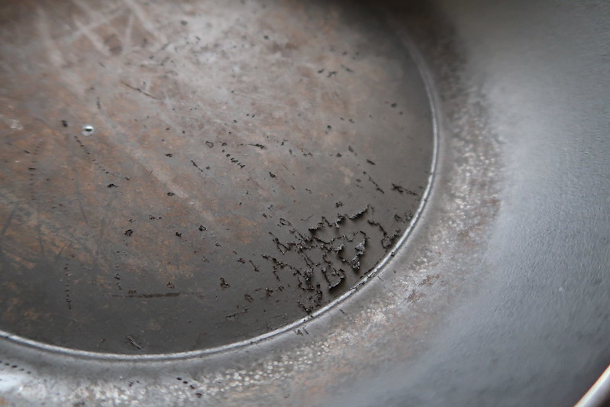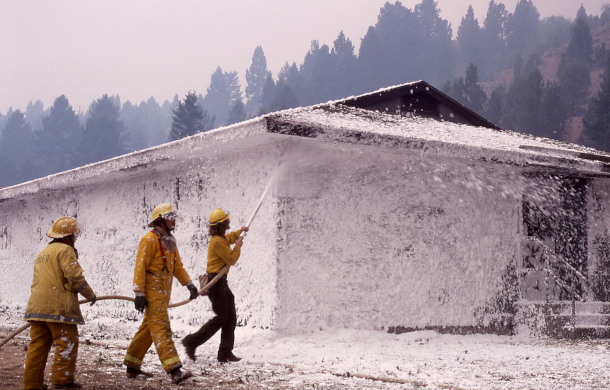EPA and Strict PFAS Water Regulations
Air Date: Week of March 24, 2023

EPA has proposed new limits on the amount of PFAS chemicals allowable in drinking water. The rules would require many utilities to install new technology to remove these harmful chemicals. (Photo: Government of Prince Edward Island, Flickr CC BY NC ND 2.0)
The EPA recently proposed new regulations that will dramatically lower the amount of PFAS chemicals that can be present in drinking water. PFAS are associated with health concerns including cancers and reproductive issues. Melanie Benesh from the Environmental Working Group tells Host Bobby Bascomb that the move is a huge win for public health.
Transcript
DOERING: From PRX and the Jennifer and Ted Stanley Studios at the University of Massachusetts, Boston this is Living on Earth. I’m Jenni Doering.
BASCOMB: And I’m Bobby Bascomb.
PFAS “forever” chemicals can be found nearly everywhere in the environment and in our drinking water. This class of more than 9000 chemicals are commonly found in a wide range of household products and possibly in the PVC pipes used to deliver water to many homes and businesses. Scientists have long warned about the health concerns associated with PFAS exposure, everything from cancers to reproductive issues. Now the Environmental Protection Agency is cracking down on the amount of these chemicals allowable in drinking water. A 2-billion-dollar investment from the bipartisan infrastructure law will help utilities comply with these strict regulations, which are widely hailed as a victory for public health. Melanie Benesh is Vice President of Government Affairs at the Environmental Working Group and joins me now for more. Melanie, welcome to Living on Earth!
BENESH: Thank you so much for having me.
BASCOMB: Can you give us a quick overview please, of EPA has proposed PFAS drinking water regulations,
BENESH: The EPA took the very historic step of proposing drinking water regulations for six different PFAS. And what the EPA did is proposed limits called maximum contaminant levels of four parts per trillion. So a very small amount for PFOA and PFOS. And then for the other for PFAS the EPA use something called a hazard index. And this is a tool that the EPA uses to address cumulative risks for mixtures of chemicals. And so the EPA takes measurements of those chemicals, weighs them against health base values that the EPA has assigned to those chemicals, and then adds them up to see whether or not it's safe. And this is really an acknowledgement by the EPA, that there are risks from being exposed to combinations of chemicals that many of these chemicals are structurally similar. They have similar health effects on the human body. And so even if an individual measurement might be safe, being exposed to the combination of those chemicals might not be safe. And so that's why they structured their drinking water that way.
BASCOMB: So these are really miniscule amounts of these PFAS chemicals that the proposed regulation would cover in drinking water. I think that probably said something about how dangerous they are. What are the public health concerns with PFAS and drinking water? And how might this proposed regulation affect public health?
BENESH: Absolutely, this proposed regulation is confirmation from the EPA that these chemicals are toxic at very low levels. As you say they are miniscule amounts. And they are associated even at those low levels with some pretty serious health concerns including some kinds of cancers like kidney and testicular cancer, developmental and reproductive harms, like preeclampsia, lower birth weights, lower sperm counts, reduced fertility, and immune harms, including making our vaccines less effective. And so this is a really significant win for public health. Drinking water is known to be a major source of exposure to PFAS. And if we have less PFAS and our drinking water, we will have lower exposure to these chemicals and therefore reduced risk of developing some of those serious health concerns that are associated with exposure to PFAS chemicals. And so if this regulation becomes final, it will reduce the risk of disease. It will save lives. It is an important win for public health
BASCOMB: And the scientific community has known for quite a while that PFAS chemicals pose a risk to public health. Why is the EPA taking this action now?
BENESH: That's right, scientists have really been sounding the alarm on these chemicals for years. And I think the reason that we're seeing action now is because communities have really stepped up and have really demanded more action from the government. We know a lot more now about how widespread these chemicals are. We know a lot more now about just how many communities have these chemicals in their drinking water. And the science has also advanced to show that these chemicals are risky and toxic at ever lower levels. And so, as that pressure has been mounting, I think we're finally seeing the actions from the EPA.

According to the US Environmental Protection Agency, Teflon and other non-stick pans may contain PFAS. This coating eventually starts to disintegrate after years of use, potentially releasing PFAS into food. (Photo: Kai Hendry, Flickr CC BY 2.0)
BASCOMB: Now to be clear, a few states around the country have created regulations to address PFAS in drinking water. How do the proposed EPA regulations compare to the state regulations that are already in place?
BENESH: There are 10 states that have final or interim drinking water limits for some of the PFAS that are covered by the EPA is proposed regulation. All of those states have higher limits than what the EPA has proposed. Because the federal limit sets a floor, those states will have to lower their limits to align with what the EPA is recommending if the EPA regulations become final.
BASCOMB: Now PFAS is a class of chemicals that includes more than 9000 individual chemicals. This proposed regulation applies to just six. Why those six in particular?
BENESH: That's right, these six PFAS chemicals are part of a larger family of chemicals called per and poly floral alkyl substances or PFAS. These are some of the most notorious PFAS chemicals. They have been shown to show up with some frequency in drinking water systems. And their health effects are particularly well documented and well studied. And in some cases, the EPA has developed toxicity values based on peer reviewed studies and the EPA own peer reviewed work, identifying the toxic effects of these chemicals. And so, these are six chemicals that I think the EPA felt very comfortable regulating. But one thing that I will say is that even though the maximum contaminant levels or MCLs is only applied to these six PFAS, the Safe Drinking Water Act is a technology driven statute. And so, the way that drinking water utilities will comply with the new regulations when they go into effect is likely by installing technology that will filter these six PFAS chemicals out of the water. But that technology, which will be designed to capture chemicals, like PFAS, won't limit itself to those six chemicals. They're not going to choose the six PFAS and let the other PFAS slip by. And so I think it's likely that the technology upgrades that we will see as a result of this regulation will address a lot more PFAS and will result in overall reductions of PFAS pretty significantly across the class of chemicals in drinking water.
BASCOMB: Can you tell us more about the technologies that will be used to remove the PFAS from the water?
BENESH: Sure, the good news is that there are a couple of off the shelf technologies that are already widely available, many of which have been used by drinking water systems for years, sometimes to treat chemicals other than PFAS. I think the most popular of these is a technology called granular activated carbon. But there are also technologies like reverse osmosis and anion exchange that are also effective at treating PFAS down to very low levels.
BASCOMB: And then what will happen to the concentrated chemicals once they're removed from the drinking water.
BENESH: Under the current system, I think a lot of that leftover waste from the treatment process is either sent to incinerators or put in landfills hopefully in a hazardous waste landfill. But neither of those are particularly good solutions. There is a lot of promising research happening for development of new destruction and disposal technologies. Most of that is still at the lab scale. But there is a lot of federal and private money that is going into researching these destruction methods. Many of them are showing a lot of promise. And so I'm hopeful that in a few years, we may see better methods for disposing of or destroying of PFAS waste in a way that's not harmful to the environment.

PFAS chemicals are now widespread in the environment and have been used in firefighting foam. (Photo: Jim Peaco, National Park Service, Wikimedia Commons public domain)
BASCOMB: Well, this is obviously a great first step in terms of public health and you know, making our drinking water safer, but as long as these chemicals are still being made, they can still be found in the infrastructure that's carrying our water. You know, it seems like a never-ending problem. Is there any talk of looking upstream and regulating the chemicals that companies can use to begin with?
BENESH: I'm so glad you asked because this is a burden that really shouldn't fall on our drinking water utilities. It shouldn't fall on ratepayers. We should not be putting so much PFAS into the environment in the first place. And it is really the polluters who are releasing PFAS into the environment who are contaminating sources of drinking water, who should be responsible for cleaning up their own mess. And so there should be more emphasis looking upstream from those sources of drinking water to make sure that those facilities also have to take action to filter their water before they discharge it or to capture their water or do whatever they can to prevent those further releases into the environment so that we're not stuck in this ever-ending cycle. Furthermore, the EPA has said that it is going to develop industry wide limits on the amount of PFASS that can be discharged from certain industries like chemical manufacturers and metal finishers. But the EPA has not proposed any deadlines for final action. The EPA has decided to ignore other sources of potential PFAS contamination like electronics manufacturers leather tanners and plastic molders and hasn't given an indication of when it might regulate other industries like landfills or textile mills. And so the EPA really needs to accelerate the pace at which it's looking at this industrial discharges issue.
BASCOMB: PFAS are found in so many things other than drinking water. I mean, you can find it in everything from cookware and food packaging to dental floss and toilet paper. How significant is exposure to PFAS via water as compared to you know, these other household products? And is there anything to suggest the government may look at these other sources of exposure, you know for future regulations.

Melanie Benesh is Vice President of Government Affairs for the Environmental Working Group. (Photo: courtesy of Environmental Working Group)
BENESH: All of those sources of exposure really matter. The EPA estimates that for most people drinking water is only about 20% of your exposure. For those exposures from consumer products, it's really important to look at the ways that we're using PFAS and eliminate the uses that we simply don't need. And states have really been leading way in banning some of these uses. Many states have banned the use of PFAS and food packaging, PFAS in firefighting foam and PFAS in cosmetics as well as in apparel and other goods. The federal government is also taking some steps to use its purchasing power to limit what they're buying. So the Biden administration issued an executive order at the end of 2021. And in that executive order directed the government to try to purchase more products that are not made with PFAS. And no administration has really done more than the Biden administration to finally address the risks from toxic chemicals like PFAS.
BASCOMB: Well, what's next for this proposed regulation?
BENESH: So one of the reasons that it has taken the EPA so long to propose this regulation is that the process under the Safe Drinking Water Act is not a quick process. And so while this is a pivotal historic step that the EPA has taken and actually proposing these regulations, a few things still need to happen before they become final. The EPA will open a docket and will accept public comment on these regulations, these proposed regulations for about 60 days, and then must finalize them by September of 2024. The EPA certainly can and should move faster than that, though, so we may see those regulations final before then. And then within the regulation will be a compliance period, so that utilities have time to upgrade their infrastructure, install whatever new technologies, they need to make sure that they can comply with those very low maximum contaminant levels. And that compliance period is usually between three and five years.
BASCOMB: Melanie Benesh is Vice President of Government Affairs at the Environmental Working Group. Melanie, thanks so much for your time today.
BENESH: Thank you so much for having me.
Links
Washington Post “EPA proposes rules to limit ‘forever chemicals’ in drinking water”
From the Living on Earth archives: “DuPont in Sticky Situation Over Teflon Chemical”
Living on Earth wants to hear from you!
Living on Earth
62 Calef Highway, Suite 212
Lee, NH 03861
Telephone: 617-287-4121
E-mail: comments@loe.org
Newsletter [Click here]
Donate to Living on Earth!
Living on Earth is an independent media program and relies entirely on contributions from listeners and institutions supporting public service. Please donate now to preserve an independent environmental voice.
NewsletterLiving on Earth offers a weekly delivery of the show's rundown to your mailbox. Sign up for our newsletter today!
 Sailors For The Sea: Be the change you want to sea.
Sailors For The Sea: Be the change you want to sea.
 The Grantham Foundation for the Protection of the Environment: Committed to protecting and improving the health of the global environment.
The Grantham Foundation for the Protection of the Environment: Committed to protecting and improving the health of the global environment.
 Contribute to Living on Earth and receive, as our gift to you, an archival print of one of Mark Seth Lender's extraordinary wildlife photographs. Follow the link to see Mark's current collection of photographs.
Contribute to Living on Earth and receive, as our gift to you, an archival print of one of Mark Seth Lender's extraordinary wildlife photographs. Follow the link to see Mark's current collection of photographs.
 Buy a signed copy of Mark Seth Lender's book Smeagull the Seagull & support Living on Earth
Buy a signed copy of Mark Seth Lender's book Smeagull the Seagull & support Living on Earth

